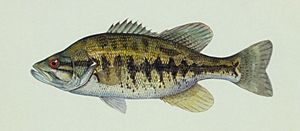Suwannee bass facts for kids
Quick facts for kids Suwannee bass |
|
|---|---|
 |
|
| Conservation status | |
| Scientific classification |
The Suwannee bass (Micropterus notius) is a type of freshwater fish. It belongs to the sunfish family, called Centrarchidae. This fish is one of the black basses. It naturally lives in only two river systems in Florida and Georgia. However, people have moved it to other places too.
Contents
What Does It Look Like?
The Suwannee bass is a fairly small fish compared to its relatives. It has a deep body and a big mouth. Inside its mouth, there's a round patch of teeth on its tongue.
Its body is mostly brown. It has about a dozen olive-colored spots on its sides. Near its head, these spots are wider than the spaces between them. But towards its tail, they blend together. They form a horizontal stripe near the base of its tail fin.
There's a big spot at the base of its caudal fin (tail fin). This spot has a light edge, which is easier to see in young fish. Young fish also have cool patterns on their dorsal fin (top fin), anal fin (bottom fin), and tail fin.
When it's time to breed, adult Suwannee bass get a pretty turquoise color. This color shows up on their cheeks, chest, and belly. This fish can grow up to 40 centimetres (16 in) long. But usually, they are around 21 centimetres (8.3 in) long. The heaviest one ever recorded weighed 1.8 kilograms (4.0 lb).
Where Do They Live?
The Suwannee bass is found only in the southeastern United States. It naturally lives in the lower parts of the Suwannee River and Ochlockonee River systems. These rivers are in Florida and a small part of Georgia. People have also introduced them to the St. Marks River and the Wacissa River in Florida.
Habitat and Life Cycle
Suwannee bass like to live in fast-moving, shallow parts of rivers. These areas are called shoals. They are often found over limestone rocks, which can be covered in sand. These fish usually prefer water that is neutral or slightly basic. This kind of water often comes from springs that flow out of aquifers in the limestone.
You won't find many Suwannee bass in the lower Suwannee River where the tides affect the water. They are also not found in the upper parts of the river. That area has acidic water from the Okefenokee Swamp.
What They Eat
The Suwannee bass mostly eats crayfish. But they also eat other small creatures without backbones, like insects. They will also eat other small fish. In the lower, tidal parts of the Suwannee River, they even eat blue crabs.
Reproduction
Suwannee bass lay their eggs from February to May. The busiest time for spawning is in April and May. This happens when the water temperature reaches about 18–19 °C (64–66 °F).
The female fish lay their eggs in round dips they dig near the edges of the streams. The male fish then fertilizes the eggs. After that, the male guards the eggs until they hatch.
Female Suwannee bass grow faster and get bigger than the males. Males rarely grow longer than 13 inches (33 cm). Females can live for up to 12 years, while males usually live for about 9 years.
Discovery and Naming
The Suwannee bass was first officially described by scientists Reeve Maclaren Bailey and Carl Leavitt Hubbs in 1949. They found the first example of this fish at the Head of Ichetucknee Springs in Columbia County, Florida.
Suwannee Bass and People
Even though they are not as famous as other black basses, people enjoy fishing for Suwannee bass as a sport. The International Game Fish Association (IGFA) has a world record for the biggest Suwannee bass ever caught. It weighed 1.75 kg (3 lb 14 oz) and was caught in the Suwannee River in 1985.
- Florida Fish and Wildlife Conservation Commission: Suwannee Bass Profile


